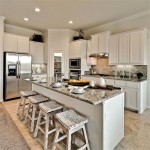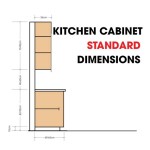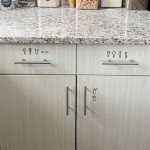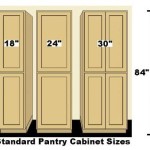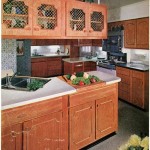Optimizing Kitchen Cabinets for Maximum Storage
Kitchen cabinets are a crucial element of any functional and aesthetically pleasing kitchen. Beyond their visual contribution, they provide essential storage for cookware, utensils, food items, and other kitchen necessities. Effective kitchen cabinet storage maximizes space utilization, improves organization, and contributes to a more efficient and enjoyable cooking experience. Strategic planning and implementation are necessary to achieve optimal storage solutions within the constraints of cabinet dimensions and available kitchen space.
The design and layout of kitchen cabinets significantly impact their storage capacity. Traditional cabinets often feature standard shelves, which can lead to wasted vertical space and difficulty accessing items at the back. Modern cabinet designs incorporate a range of innovative storage solutions to address these challenges. Pull-out shelves, drawer dividers, vertical dividers, and specialized organizers are examples of features that enhance accessibility and maximize storage potential. The choice of cabinet design should consider the specific storage needs of the homeowner and the overall kitchen layout.
Proper organization is paramount to maximizing kitchen cabinet storage. Without a systematic approach, cabinets can quickly become cluttered and inefficient. Implementing a well-defined organizational system, such as grouping similar items together, utilizing vertical space, and regularly decluttering, can significantly improve storage efficiency. The principles of organization extend beyond the arrangement of items within the cabinets to encompass the overall flow and functionality of the kitchen.
Understanding Cabinet Types and Their Storage Potential
Kitchen cabinets are available in a variety of types, each offering unique storage capabilities. Base cabinets, wall cabinets, and pantry cabinets are the primary categories. Base cabinets, located under the countertops, are typically used for storing larger items such as pots, pans, and small appliances. Wall cabinets, mounted on the walls above the countertops, are ideal for storing dishes, glassware, and food items. Pantry cabinets, which can be either freestanding or built-in, provide ample storage space for dry goods, canned goods, and other non-perishable items.
Within each category, further variations exist. Base cabinets can include drawers, pull-out shelves, and corner cabinets with lazy Susans or specialized corner organizers. Wall cabinets may feature adjustable shelves, glass fronts, or built-in lighting. Pantry cabinets can be customized with adjustable shelves, pull-out drawers, and door-mounted racks. The selection of cabinet types should be based on a comprehensive assessment of storage needs and available space.
The material and construction of kitchen cabinets also influence their durability and storage capacity. Solid wood cabinets are known for their strength and longevity, while laminate or wood veneer cabinets offer a more affordable alternative. The quality of the hardware, such as hinges and drawer slides, is crucial for ensuring smooth operation and long-term reliability. Investing in high-quality cabinets can contribute to improved storage performance and increased lifespan.
Implementing Effective Organization Strategies
Organizing kitchen cabinets requires a systematic approach that considers the specific items being stored and the available space. Start by decluttering the cabinets, removing any items that are no longer needed or used. This process frees up valuable space and allows for a more efficient organization system. Next, group similar items together and determine the most appropriate storage location for each group.
Vertical space is often underutilized in kitchen cabinets. Utilizing shelf organizers, risers, and stackable containers can maximize vertical storage and prevent items from being piled on top of each other. Drawer dividers and inserts can help keep utensils, cutlery, and other small items organized and easily accessible. Using clear containers allows for easy identification of contents, reducing the need to rummage through cabinets.
Regular maintenance is essential for maintaining an organized kitchen. Periodically decluttering and reorganizing the cabinets can prevent clutter from accumulating and ensure that items remain easily accessible. Cleaning the cabinets regularly can help prevent the buildup of dust and grime, contributing to a more hygienic and aesthetically pleasing kitchen environment. Simple habits, such as putting items back in their designated places after use, can significantly improve organization and prevent cabinets from becoming cluttered again.
Consider the placement of items based on frequency of use. Frequently used items should be stored in easily accessible locations, such as on the lower shelves or in front of other items. Less frequently used items can be stored on higher shelves or in the back of cabinets. This arrangement ensures that the most important items are readily available when needed.
Maximizing Space with Innovative Storage Solutions
Several innovative storage solutions can significantly enhance the storage capacity and functionality of kitchen cabinets. Pull-out shelves, also known as roll-out trays, allow for full access to items stored at the back of the cabinet. These shelves are particularly useful for storing pots, pans, and other bulky items that can be difficult to reach.
Corner cabinets often present a storage challenge due to their awkward shape and limited accessibility. Lazy Susans and other corner organizers rotate to bring items to the front, making them easily accessible. These organizers are ideal for storing spices, canned goods, and other small items.
Vertical dividers are useful for storing baking sheets, cutting boards, and other flat items. These dividers prevent items from sliding around and maximize the use of vertical space. Door-mounted racks can be used to store spices, cleaning supplies, or other small items. These racks utilize the often-unused space on the inside of cabinet doors.
Under-sink organizers provide a convenient storage solution for cleaning supplies and other items that are typically stored under the kitchen sink. These organizers often include adjustable shelves, drawers, and other features that maximize space and improve organization. Utilizing these solutions requires assessing the specific needs of the space and selecting the products that best fit the available area and intended purpose.
Spice racks offer designated storage for spices, preventing them from getting lost or cluttered in cabinets. These racks can be mounted on the wall, inside a cabinet door, or placed on a countertop. Choosing the right spice rack ensures that spices are always within easy reach.
Consider custom cabinet solutions for unconventional spaces or unique storage needs. Custom cabinets can be designed to fit specific dimensions and incorporate specialized storage features. This option offers flexibility and can maximize storage potential in kitchens with unusual layouts.
Proper lighting within kitchen cabinets can also improve storage functionality. LED strip lights installed inside cabinets can illuminate the contents, making it easier to find items and preventing items from being overlooked. This is especially helpful in dark or poorly lit kitchens.
The selection and implementation of effective storage solutions are essential for optimizing kitchen cabinet space. By carefully considering the available space, storage needs, and organizational strategies, homeowners can create a functional and efficient kitchen that enhances their cooking experience.

5 Tips Tricks For Kitchen Cabinet Storage

10 Kitchen Storage Cabinets For Small Spaces Taste Of Home

Check Out These Simple Ideas For Kitchen Storage Organisation

Creative Kitchen Cabinet Storage Solutions Craig Allen Designs

30 Kitchen Cabinet Add Ons You Can Diy Family Handyman

The 15 Most Popular Kitchen Storage Ideas On Houzz

60 Clever Cabinet Organization Tips To Double Your Storage 2024

Custom Cabinet Storage Solutions Kitchen Magic

Kitchen Pantry Storage Ideas To Organize Your Cabinets

Kitchen Base Cabinets What You Should Never In Lower


